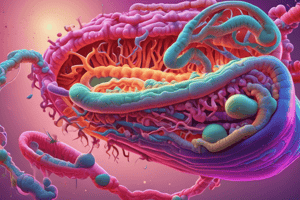Podcast
Questions and Answers
What are the two main components of the refluxate that contribute to the development of Barrett's esophagus?
What are the two main components of the refluxate that contribute to the development of Barrett's esophagus?
- Bile salts and pancreatic enzymes
- Gastric acid and bile salts (correct)
- Gastric acid and pepsin
- Pepsin and pancreatic enzymes
Which of the following is considered a complication of gastroesophageal reflux disease (GERD)?
Which of the following is considered a complication of gastroesophageal reflux disease (GERD)?
- Esophageal adenocarcinoma (correct)
- Esophageal stricture
- Peptic ulcer disease
- Gastritis
What is the process by which GERD can lead to the development of Barrett's esophagus?
What is the process by which GERD can lead to the development of Barrett's esophagus?
- Decreased motility of the esophagus
- Weakening of the lower esophageal sphincter
- Chronic inflammation of the esophageal mucosa (correct)
- Increased production of gastric acid
What is the significance of the development of Barrett's esophagus in the context of GERD?
What is the significance of the development of Barrett's esophagus in the context of GERD?
Which of the following is a risk factor for the development of Barrett's esophagus?
Which of the following is a risk factor for the development of Barrett's esophagus?
What is the main risk factor for the development of gastric cancer according to the passage?
What is the main risk factor for the development of gastric cancer according to the passage?
What is the pathological sequence described in the passage that can lead to gastric cancer?
What is the pathological sequence described in the passage that can lead to gastric cancer?
What is the primary mechanism by which Helicobacter pylori infection can lead to gastric cancer according to the passage?
What is the primary mechanism by which Helicobacter pylori infection can lead to gastric cancer according to the passage?
Which of the following is NOT a potential complication of Helicobacter pylori infection according to the passage?
Which of the following is NOT a potential complication of Helicobacter pylori infection according to the passage?
Which of the following best describes the role of intestinal metaplasia in the progression to gastric cancer according to the passage?
Which of the following best describes the role of intestinal metaplasia in the progression to gastric cancer according to the passage?
Which of the following is NOT a common endoscopic factor associated with Barrett's esophagus?
Which of the following is NOT a common endoscopic factor associated with Barrett's esophagus?
What is the primary goal of ablative therapy for Barrett's-related neoplasia?
What is the primary goal of ablative therapy for Barrett's-related neoplasia?
Which of the following histologic factors is associated with an increased risk of neoplastic progression in Barrett's esophagus?
Which of the following histologic factors is associated with an increased risk of neoplastic progression in Barrett's esophagus?
Which of the following endoscopic factors is NOT commonly associated with Barrett's esophagus?
Which of the following endoscopic factors is NOT commonly associated with Barrett's esophagus?
What is the primary mechanism by which ablative therapy aims to treat Barrett's-related neoplasia?
What is the primary mechanism by which ablative therapy aims to treat Barrett's-related neoplasia?
Flashcards are hidden until you start studying




